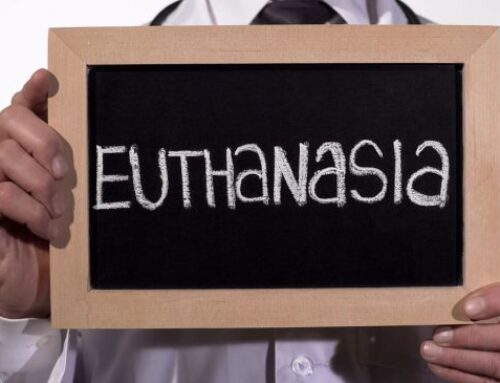
It is difficult to imagine how a fair-minded reader of Debating Euthanasia could come to any conclusion but that Keown is right: euthanasia is an unmitigated evil that can never be justified.
Emily Jackson and John Keown are two of the foremost experts on the law as it relates to euthanasia in Britain and the United States. Together, they have written a most informative book, Debating Euthanasia, (Hart Publishing, 2011) in which they respectively present the main arguments for and against legalizing euthanasia and physician-assisted suicide.
Jackson, a professor of law at the London School of Economics, is a leading proponent of euthanasia in Britain. To begin with, she notes that it is well established in law that a physician can legally provide a patient who is dying of cancer with enough opioids to control pain even at the foreseeable risk of hastening death, provided the physician intends only to alleviate the pain and not to kill the patient. “If this is acceptable,” she writes, “why not allow death to be hastened using a muscle relaxant drug, and with the open and transparent acknowledgement – as is normal in the law – that if you do something knowing that a particular outcome is ‘virtually certain,’ or even just ‘reasonably foreseeable,’ you should be judged responsible for bringing about that outcome?”
Keown, Rose F. Kennedy Professor of Christian Ethics at the Kennedy Institute of Ethics at Georgetown University, has no difficulty in disposing of this argument. On the basis of a careful exposition of the doctrine of double effect, he persuasively argues that there is a fundamental moral and legal difference between deliberately killing a patient and acting only with the intent of comforting the patient through the administration of pain relief: the former is murder; the latter is compassionate care.
Furthermore, the courts have repeatedly affirmed this difference between murder and compassionate care in end-of-life cases. Keown recalls an instance when Lord Goff, a senior appellate court judge in Britain, pointed out that it is not just physicians who can have “foresight without intention” in performing an action. As an example, Goff wrote: “When Field Marshal Montgomery invaded France on D-day, he foresaw that many of the troops under his command would be killed on that very day. Obviously, however, he did not intend that any of them should be killed.”
Regardless, Jackson observes that unintentional excuse for hastening death does not apply to the practice of terminal sedation. She writes: “If the doctor is allowed to give an injection (unquestionably an action) containing sedatives that will induce a coma, and is then entitled to withdraw the patient’s feeding tube, thus causing her death, it is hard to see why giving an injection which contains both a sedative to induce a coma and a muscle relaxant to stop breathing is regarded as an entirely different course of action – namely murder – and is punishable by life imprisonment.”
On this point, Jackson is essentially correct. In Canadian law, a physician who first sedates and then slowly and deliberately kills a comatose patient by withholding nutrition is liable to be charged under section 215 of the Criminal Code with failure to provide the patient with “the necessaries of life,” an offence punishable by up to five years in prison.
In Canada, this is the law as it is and as it should be. The provision of nutrition and hydration by artificial means is not a form of medical treatment: it is a basic requirement of palliative care that should never be withdrawn so long as the procedure comforts and sustains the patient.
Among other arguments, Jackson suggests that physicians surreptitiously engage in euthanasia even in countries where the practice is illegal so why not legalize euthanasia so that the deliberate killing of patients by physicians can be brought out into the open and effectively regulated?
We have heard this argument before in the case of abortion where legalization has resulted in a catastrophic increase in the killing of babies in the womb by physicians. There is no reason to believe that the results of legalizing euthanasia would be any less tragic especially for the sick, the frail, the elderly and the handicapped. Keown notes that the Netherlands has the toughest safeguards for legalized euthanasia, yet a report commissioned by the Dutch government found that no fewer than 1,000 patients were involuntarily euthanized by a lethal injection – a form of killing by physician that still constitutes murder in Dutch law.
It is difficult to imagine how a fair-minded reader of Debating Euthanasia could come to any conclusion but that Keown is right: euthanasia is an unmitigated evil that can never be justified.




